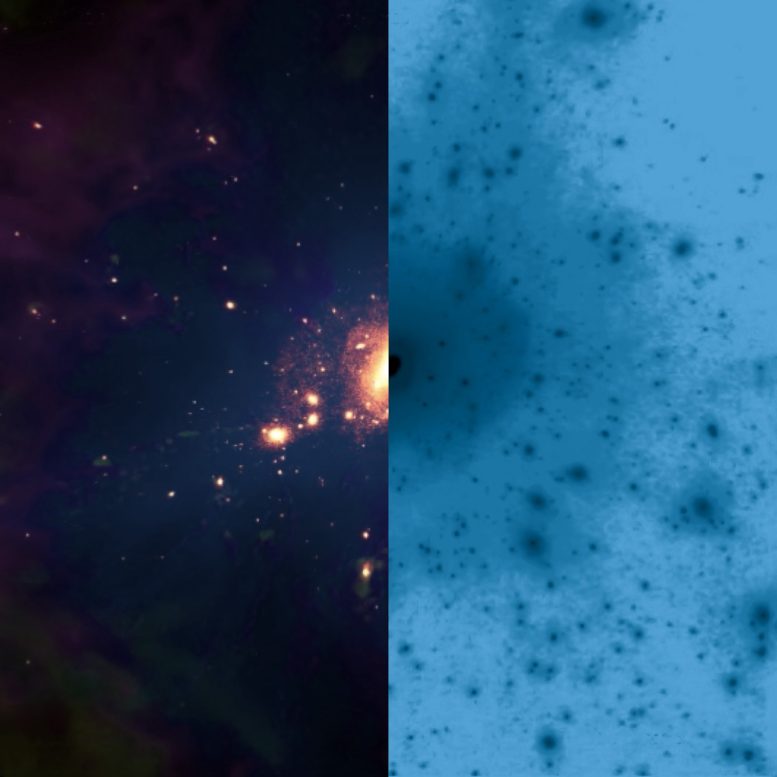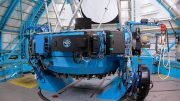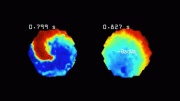
Image of a galaxy showing, on the left, its stellar component, and on the right (in negative), the dark matter present in its halo. Credit: Gabriel Pérez Díaz, SMM (IAC) / The EAGLE team
Dark matter constitutes approximately 85% of the universe’s total matter. Unlike ordinary matter, which interacts with light through absorption, reflection, and emission, dark matter remains invisible, posing challenges to its direct observation. Its presence is deduced through the gravitational influence it exerts on visible matter, such as stars, planets, and various celestial bodies.
Galaxies are made up of these two types of material: dark matter which is distributed in halos, which are huge structures surrounding galaxies, and ordinary matter which is mainly present in the central regions where most of the stars are found.
Traditionally observational studies of galactic evolution have centred on the role of ordinary matter, even though it is quite a small fraction of the mass of a galaxy. For decades there have been theoretical predictions about the effect that dark matter should have on the evolution of galaxies. However, in spite of numerous efforts, there is no clear consensus about this.
Breakthrough in Dark Matter Research
Now, research led by a team at the IAC has managed to confirm, for the first time using observations, the effect of dark matter on galaxy evolution. “Dark matter has an obvious effect on galaxies because we can measure it, but the effect on the evolution of galaxies which we have found is something which had been proposed, even though we did not have a technique for studying it observationally” explains Laura Scholz Díaz, a pre-doctoral researcher at the IAC and first author of the article.
To study the effect of dark matter the team has concentrated on the difference between the mass of the stars in a galaxy, and the mass which can be inferred from its rotation, called the total dynamical mass. The research showed that the ages, the metal content, the morphology, the angular momentum, and the rate of formation of the stars depend not only on the mass of those stars, but also on the total mass, and this means including the dark matter component which fits the estimates of the halo mass.
“We have seen that in galaxies with equal masses of stars, their stellar populations behave differently depending on whether the halo has more, or less dark matter, in other words, the evolution of a galaxy, from its formation until the present time is modified by the halo in which it is contained. If it has a more or a less massive halo, the evolution of the galaxy over time will be different, and this will be reflected in the properties of the stars which it contains” adds Ignacio Martín Navarro, an IAC researcher who is a co-author of the article.
Future Research Directions
In the future, the team plans to make measurements of stellar populations at different distances from the center of the galaxy, and to show whether this dependence on the dark matter halo of the properties of the stars is maintained at all radii. The following step in the research will allow the study of the relation between dark matter halos and the large-scale structure of the Universe.
“These dark matter halos are not created alone they are connected by filaments which form part of the large-scale structure, called the ‘cosmic web’,” says Scholz. “The mass of the halo appears to modify the property of its galaxy, but it could be the result of the position occupied by each halo within the cosmic web. In the coming years we want to see the effect of this large-scale structure in the context we are studying” she explains.
This study is based on 260 galaxies of the CALIFA (Calar Alto Legacy Integral Field Area) an international project in which the IAC participates actively under the coordination of Jesús Falcón Barroso, another co-author of the article. “This survey gives spectral information, and gives unprecedented spatial cover of galaxies,” he says. “These galaxies were observed in a high-resolution configuration, to obtain detailed measurements of their kinematic properties, which allowed us to study the motions of the stars very precisely, and so infer the total masses of the galaxies.”
Reference: “Baryonic properties of nearby galaxies across the stellar-to-total dynamical mass relation” by Laura Scholz-Díaz, Ignacio Martín-Navarro, Jesús Falcón-Barroso, Mariya Lyubenova and Glenn van de Ven, 19 February 2024, Nature Astronomy.
DOI: 10.1038/s41550-024-02209-8









I am afraid my most pertinent comments would negatively impact on your article.